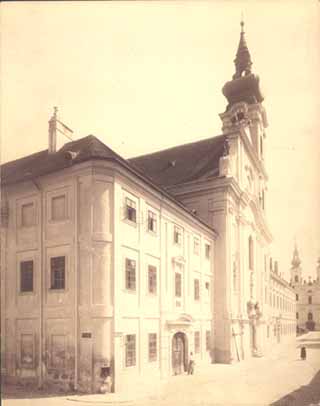
Monastery, church and hospital of the Elizabeth Nuns at about 1900
Az Erzsébet-apácák kolostora, temploma és kórháza 1900 körül
History
St. Francis’s Wounds Church is the oldest church in Watertown, and it was consecrated in the honor of wounds of St. Francis of Assisi. It was built according to Jakab Hans’ plans on the ruins of an old mosque.
After expelling the Ottoman Turks, Bosnian grey friars settled down at this place, and the construction of their monastery started in 1701. Foundation stone of the new church was set in 1731, and it was completed in 1741. The high altar and appointments became ready in 1756.

By the invitation of Joseph II, 18 St. Elisabeth nuns from Vienna opened the first women’s hospital in Pest-Buda with 20 beds in the vacated grey friars’ monastery in 1785. Besides taking care of the ill, the sisters kept a kitchen for the poor in the neighborhood.
In 1805, the building flared with a new wing for the convalescents on the northern side of the church. The expansion was financed by the foundation of István Marczibányi and his wife.
In 1831, a cholera hospital was opened in the building where the nuns attended the sick risking their life. Abbess Pulcheria Mária Lenauer and two other sisters became the victim of the epidemic.
In the pharmacy of the monastery, the sisters prepared the medicines by themselves. The so-called Elizabeth Balls (Globuli ad erysipelas Monialum Sanctae Elisabethae) against the erysipelas was one of the sisters’ oldest medications.
The hospital of the Elizabeth nuns of Buda took care of women only (except for wartime) with 40 beds in 1817, 60 beds in 1892 and 130 beds from 1928. The sisters were trained nurses and their number was 26 in 1885, 32 in 1899, 39 in 1911, 40 in 1917, 62 in 1941, 58 in 1945, and 48 in 1948.
In 1944, they hid more than 100 Jewish with the reason of illness and saved many Jewish from the Buda brickyard. In 1950, they attended the sick not only in the hospital on the Main Street, but also in the Ujpest town hospital and in two other social institutions.
In 1950, 69 nuns had to leave the house after dissolution of the sisterhood. The well-skilled sisters tried to be employed at the medical corps and most of them succeeded after a time. By meeting regularly in their church, they managed to keep the ties of their communion.
In 1990, 25 Elizabeth nuns started to reorganize their sisterhood. They received their house functioning as a social home in the meantime back, but the Maltese Charity Service attends the mostly old helpless people. The nuns plan to participate in the medical attendance together with the new applicants.
Getting to the monastery
The monastery is accessible
- by car: regulated and free parking is also available.
- by bicycle: the EuroVelo 6 European cycle route runs along the Danube.
- by public transportation: by public transportation to Batthyány square and on foot from that.
Important: There is no pen in the cache, so bring your own! The hiding place is busy in the day time. Watch out for muggles!
Please indicate in your log if there is a problem with the cache: the logbook is becoming full, the box is damaged, ...
Thanks for your help! :)

Arrival of the Elizabeth Nuns at Buda in 1785
Az Erzsébet-apácák megérkezése Budára 1785-ben
Történelem
A Szent Ferenc Sebei templom a Víziváros legrégebbi temploma, mely ma is Assisi Szent Ferenc sebei tiszteletére van felszentelve. Hans Jakab tervei szerint építették meg egy régi mecset romjain.
A török kiûzése után bosnyák ferences szerzetesek telepedtek meg ezen a helyen, a kolostoruk építkezése 1701-ben kezdõdött meg. 1731-ben rakták le az új templom alapkövét, mely 1741-re lett készen. A fõoltár és a berendezés 1756-ra készült el.

1785-ben, II. József meghívására, 18 bécsi Szent Erzsébet apáca nyitotta meg Pest-Buda elsõ nõi kórházát 20 ággyal az elõzõleg kiürített ferences kolostorban. A nõvérek a betegápolás mellett ínségkonyhát is tartottak fenn a környék szegényei számára.
1805-ben az épülettömb a lábadozó betegek számára épült új szárnnyal bõvült a templom északi oldalán. A költségeket Marczibányi István és neje alapítványából fedezték.
1831-ben kolerakórházat nyitottak az épületben, ahol az apácák életük kockáztatásával ápolták a tömegesen ide menekült betegeket. Az akkori fõnöknõ, Lenauer Mária Pulcheria és másik két nõvér is a járvány áldozata lett.
A kolostor gyógyszertárában az orvosságokat a nõvérek készítették. A nõvérek régi gyógyszerei közé tartozott az orbánc elleni, ún. Erzsébet-golyó (Globuli ad erysipelas Monialum Sanctae Elisabethae).
A budai Erzsébet-apácák kórháza 1817-ben 40, 1892-ben 60, 1928-tól pedig 130 ággyal csak nõi betegeket fogadott (kivéve a háborús éveket). A szakképzett nõvérek száma 1885-ben 26, 1899-ben 32, 1911-ben 39, 1917-ben 40, 1941-ben 62, 1945-ben 58, 1948-ban 48 fõ volt.
1944-ben betegség címén több mint 100 zsidót rejtegettek, és számos zsidót mentettek ki az óbudai téglagyárból is. 1950-ben a Fõ utcai kórházon kívül az újpesti városi kórházban, és két szociális intézetben is gondozták a betegeket.
A rend feloszlatásakor, 1950-ben, 69 apácának kellett távoznia a házból. A kiválóan képzett nõvérek igyekeztek az egészségügyben elhelyezkedni; egy idõ után többségük sikerrel járt. Templomukban rendszeresen találkozva a lelki közösség kötelékeit is megõrizték.
1990-ben 25 Erzsébet nõvér kezdte meg újjászervezni a közösségi életet. Az idõközben fõvárosi szociális otthonként mûködõ házukat napjainkban visszakapták, de a fõleg idõs, magatehetetlen emberek gondozását a Máltai Szeretetszolgálat végzi (Szent Erzsébetrõl nevezett Idõsek Otthona és Gondviselés Háza), de az új jelentkezõkkel együtt az apácák azt tervezik, hogy õk is szervezetten bekapcsolódnak a gondozásba.
A kolostor megközelítése
A kolostor elérhetõ
- autóval: fizetõ és nem fizetõ parkolás áll rendelkezésre.
- kerékpárral: a nemzetközi EuroVelo 6 kerékpárút fut a Duna mentén.
- tömegközlekedéssel: tömegközlekedéssel a Batthyány térig és onnan gyalog.
Fontos: Nincs toll a ládában, ezért hozd magaddal a sajátodat! A rejtekhely forgalmas napközben. Vigyázz a muglikra!
Kérlek jelezd a logodban, ha valami probléma van a ládával: a logbook kezd betelni, a doboz megsérült, ...
Köszönet a segítségedért! :)